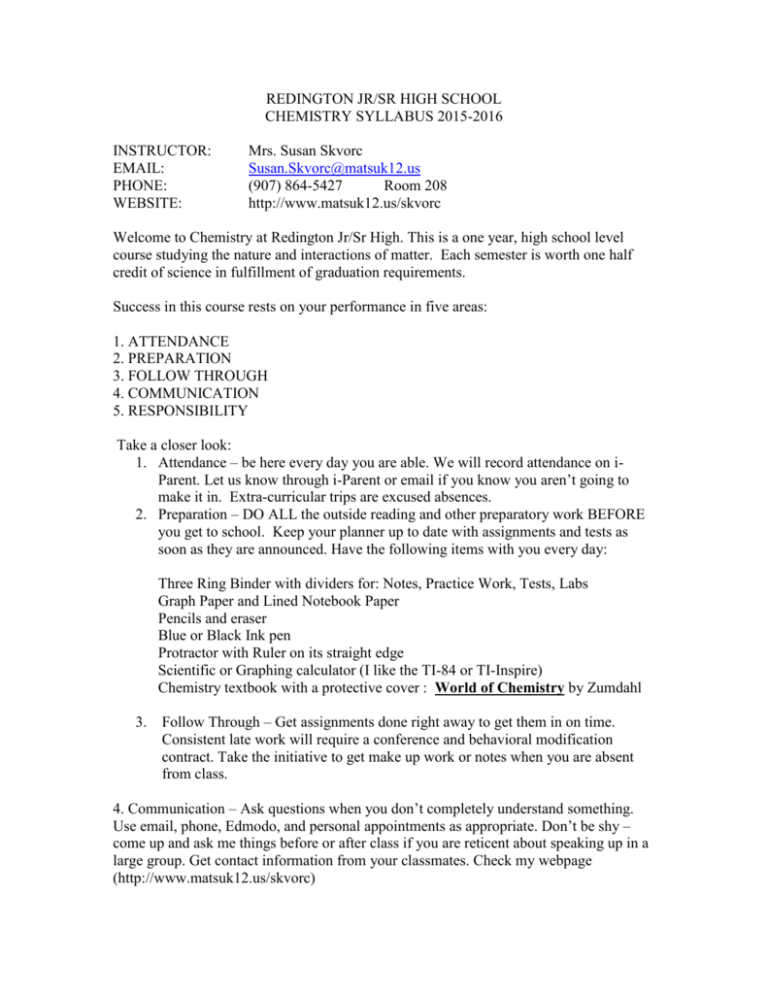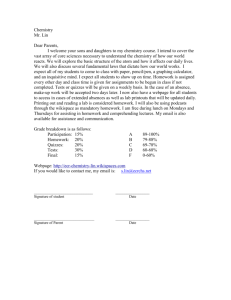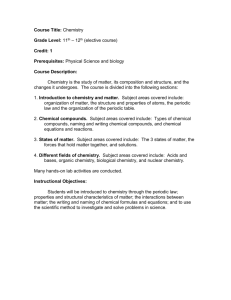Chemistry syllabus
advertisement

REDINGTON JR/SR HIGH SCHOOL CHEMISTRY SYLLABUS 2015-2016 INSTRUCTOR: EMAIL: PHONE: WEBSITE: Mrs. Susan Skvorc Susan.Skvorc@matsuk12.us (907) 864-5427 Room 208 http://www.matsuk12.us/skvorc Welcome to Chemistry at Redington Jr/Sr High. This is a one year, high school level course studying the nature and interactions of matter. Each semester is worth one half credit of science in fulfillment of graduation requirements. Success in this course rests on your performance in five areas: 1. ATTENDANCE 2. PREPARATION 3. FOLLOW THROUGH 4. COMMUNICATION 5. RESPONSIBILITY Take a closer look: 1. Attendance – be here every day you are able. We will record attendance on iParent. Let us know through i-Parent or email if you know you aren’t going to make it in. Extra-curricular trips are excused absences. 2. Preparation – DO ALL the outside reading and other preparatory work BEFORE you get to school. Keep your planner up to date with assignments and tests as soon as they are announced. Have the following items with you every day: Three Ring Binder with dividers for: Notes, Practice Work, Tests, Labs Graph Paper and Lined Notebook Paper Pencils and eraser Blue or Black Ink pen Protractor with Ruler on its straight edge Scientific or Graphing calculator (I like the TI-84 or TI-Inspire) Chemistry textbook with a protective cover : World of Chemistry by Zumdahl 3. Follow Through – Get assignments done right away to get them in on time. Consistent late work will require a conference and behavioral modification contract. Take the initiative to get make up work or notes when you are absent from class. 4. Communication – Ask questions when you don’t completely understand something. Use email, phone, Edmodo, and personal appointments as appropriate. Don’t be shy – come up and ask me things before or after class if you are reticent about speaking up in a large group. Get contact information from your classmates. Check my webpage (http://www.matsuk12.us/skvorc) at the school’s website for updates and information: www.matsuk12.us/rjs takes you to the school page. Click on Staff and my name for a link to the Chemistry page. 5. Responsibility – the bottom line: this is YOUR education and you must take responsibility for your own learning. If you are not internally motivated, no one can make you do anything; you have to want it. Get the job done and ask for help when you need it. I have a vested interest in your success! GRADING POLICY I am a firm believer that high self esteem results from achievement and is earned, not given. Grades are assigned as follows: A: 90 – 100 %; B : 80 -89% ; C: 70- 79%; D: 60 – 69%. Total percent less than 60 results in no credit. Summative assessments: Practice assignments: Lab work: 60 % of grade 20 % 20 % Summative assignments are things you do after sufficient practice work is complete, such as quizzes, unit tests, reports, projects. There will be practice problems, lab reports, short quizzes, chapter tests, and a final exam. There is no extra credit, but each semester you may retake one chapter test and retain the higher of the two scores. Highly motivated students may earn extra points for extending their mastery beyond what is required. You may not retake the final exam. Classroom Expectations: Be on time. Be respectful of others and their property. Try your best every day. Please leave all your electronic devices in your bag/pocket during class. Your focus is to be on chemistry during this time. Do not plan on using your phone as a calculator for tests and quizzes. Please consume food and drink outside of the classroom. Closed containers with water, coffee, tea and such is okay. Return the following sheet with signatures as soon as possible. Keep this document in your notebook for reference. A copy is on the website if you need to print another. Please return this page after you print your name, sign it and have parents sign that the information in this syllabus has been read and understood. If you do not understand any part of it, please call or email for clarification before signing. Parents: please include your preferred email address and phone number for contact regarding your student’s participation in this class. Thank you. CHEMISTRY Student Name: ___________________________________________________________ Student Signature: ________________________________________________________ Parent Signature: _________________________________________________________ Parent Email: _______________________________________ Phone:_______________ Please print clearly. For Teacher Use: Textbook # _______________ Parent Contact Record: Date Subject matter: Include below any notes or information you wish to share with me as we partner in the education of your student: CHEMISTRY OUTLINE: Subject to change as needed. Read pages xxii – xxix and chapter 1 to practice note taking skills and how to answer questions. Before each class there is an assigned reading over which you will need to take notes. QUARTER 1 Week 1- 3 Chapter 1: Introduction The Science of Chemistry Using Science to Solve Problems Learning Chemistry Chapter 5: Measurements and Calculations Scientific notation Uncertainty and sig figs Problem solving and unit conversion Week 4-5 Chapter 2: Matter: Particulate Nature of Matter Elements & compounds States of Matter Physical & chemical properties Week 5-6 Chapter 3: Chemical Foundations Elements Atoms and Compounds Atomic Structure The Periodic table Week 7-9 Chapter 4: Nomenclature: Binary Compounds Naming Acids, polyatomic ions, etc QUARTER 2 Week 10 – 12 Chapter 6: Chemical composition Atoms and Moles Molar Mass and Percent Composition Formulas of Compounds Week 13 Chapter 7: Chemical Reactions Intro Evidence of chemical reaction Chemical equations Balancing equations Week 14 – 16 Chapter 8: Reactions in Aqueous Solutions Understanding Reactions Acids & Bases; Metals & Non-metals Classifying Reactions Week 17 -18 Review and Final exam SPRING SEMESTER: QUARTER 3 Week 1 – 3 Chapter 9: Chemical Quantities Using Chemical equations Using equations to calculate mass Limiting reactants & Percent yield Week 4-5 Chapter 10: Energy Energy, temperature and heat Flow of Energy Energy and chemical reactions * Using Energy in the real world Week 6 – 8 Chapter 11: Modern Atomic Theory Atoms and Energy Hydrogen Atomic Orbitals Electron Configuration & Atomic Properties Week 9 – 10 Chapter 19: Radioactivity and Nuclear Energy Radioactivity Applications QUARTER 4 Week 11-12 Chapter 12: Chemical Bonding Characteristics of chemical bonds Characteristics of Ions and Ionic Compounds Lewis structures Structures of Molecules * Week 13 – 14 Chapter 13: Gases Describing the Properties of Gases Using Gas Laws to solve problems Using a model to describe gases Week 15 – 18 Chapter 14: Liquids and Solids Intermolecular forces and phase changes Vapor Pressure and Boiling Point Properties of solids Chapter 15: Solutions Forming solutions Describing solution composition Properties of Solutions Chapter 16: Acids and Bases Properties of acids and bases Determining the acidity of a solution Titrations and Buffers





